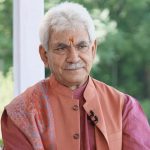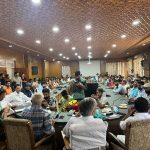FRAGRANCE OF IDEAS
Finally, the Ramjanambhumi Mandir in Ayodhya has been inaugurated and the “Pran-Pratishtha” of Shri Ramlalla has also been duly accomplished on 22nd January 2024. With this comes to an end the Ramjanambhumi movement and the wait for the grand temple dedicated to Shri Ram at his birthplace. It is also the culmination of the last 500 years of long struggle which witnessed hundreds and thousands of sacrifices made by the devotees of Shri Ram and the bunches of the nationalist and patriotic activists for the cause. In the current context, there are innumerable people who deserve credit for this great and historical achievement and many more throughout the globe can also claim the same but the real credit for the Ram Mandir goes to the hundreds of thousands of activists of RSS, VHP and BJP.
In addition to the three factors of RSS-VHP-BJP combine, the ‘sant-samaj’ of the country also contributed to the success of the movement wholeheartedly and with a sense of purpose. During the decade of 1980s, the socio-political scenario in the country was undergoing a very tumultuous period. While all this was going on at the political front, there was another thinking simultaneously taking shape in a socio-cultural sphere. This was spearheaded by the top leadership of the RSS and VHP at Nagpur and Delhi. They were seriously going for an action-plan to raise the issues of the three most sacred places of worship for the Hindus, ie Ayodhya, Kashi and Mathura.
The governments of all hues from 1950 to 1985 remained quite indifferent to these important issues of concern for the Hindu society and also towards the consequent ramifications of the discontent among the society in this regard. Instead, the policy of Muslim appeasement adopted by all the governments irked the Hindu society at large. There is one instance to show when a high level Muslim delegation went to meet the then Prime Minister, Morarji Desai in 1977, after the Janta Party’s victory in the elections, that the people in command raised these issues with the Muslim community. When the delegation put its demands before the Prime Minister for their redressal, Morarji Desai assured them to look into all the demands provided the delegation assured him also about an issue of concern of the Hindu community. He asked the delegation that it would be beneficial for the Muslim community as well as for the whole country in case the Muslims agree to leave their claim on the three most important sacred places of Hindus at Ayodhya, Mathura and Kashi. The Muslim delegation kept silent over the issue and came out as a disgruntled block out of the meeting hall.
This time around, the main purpose was to again persuade the Muslim community of India to leave their claim on the three most sacred places of Hindus where medieval foreign Muslim invaders/rulers had razed the Hindu temples to the ground and instead instituted mosques in their place. It was decided in the marathon meetings held one after the other to firstly focus on the Ayodhya issue since in Ayodhya, the disputed Ramjanambhumi structure was a functional temple and what was called the ‘Babri-Masjid’ was actually a non-functional mosque. The Faizabad administration had put a lock on the sanctum-sanctorum of the functional temple where Ramlalla-Virajman was worshipped daily by the designated pujari since 1949. RSS handed over the responsibility of the sensitive project to its senior functionary and the most experienced and able organiser, Moropant Pingle.
On the front of Vishwa Hindu Parishad, Ashok Singhal, the then General Secretary of VHP took the whole responsibility upon his shoulders and involved the ‘sant-samaj’ of the Hindu community in the movement for the liberation of Ram Janambhumi. It was he who brought all Dharamacharyas on one stage to pursue the cause. With the guidance, help and logistic support of the Rashtrya Swyamsevak Sangh, a formidable alliance of RSS-VHP and ‘sant-samaj’ made an indelible impression on the movement that spread at an all-India level. It had a great impact on the society at large which supported the movement at every important stage and step. The series of developments like Ekatmata Yatra, Ram-Janaki Rath Yatras, unlocking of the Ramjanambhumi structure, Shila-pujan, Shila-nyas and the following Karseva caught the imagination of the people throughout the length and breadth of the country. It was perceived as a cultural revolution by the masses in India.
It was at this stage that the Bhartiya Janta Party decided to plunge into the Ramjanambhumi movement to take it to the next level. It passed a resolution in 1989 in its National Executive meeting in Shimla to the effect that the Ramjanambhumi-Babri dispute need to be settled either through negotiations or by incorporating a law in this regard. The role of BJP remained exemplary in a historic sense. Along with the RSS and VHP, the BJP didn’t only contributed greatly to the movement but also suffered immensely throughout the movement. L.K.Advani was arrested in 1990 during the Somnath to Ayodhya Rath Yatra in Bihar and put under house arrest. The BJP consequently withdrew its support to the V.P. Singh government and decided to sit in the opposition in the parliament.
When the demolition of the disputed structure in Ayodhya took place in December 1992, the first causality was the state government headed by Kalyan Singh in UP. He resigned on his own taking the responsibility of the demolition. Thereafter, three more elected BJP governments were dismissed in HP, MP and Rajasthan. RSS, VHP and Bajrang Dal were banned by the government and their activities were forbidden. However, when these cases were referred to the Tribunals constituted under law, the Tribunal quashed the orders of the Central government. Cases were filed against the BJP-RSS-VHP leaders in the demolition case which were dragged for decades together. Kalyan Singh was held responsible for dereliction of his duties and was symbolically awarded a one-day imprisonment by the Supreme Court of India which he underwent with grace and pride.
For the sake of argument, it is said that the Ramjanambhumi movement also gave a huge dividend to the BJP electorally, but that opportunity was also available to the other political parties as well. Instead they opposed the movement, their governments tortured and killed the activists of the movement and made every effort to tarnish the image of RSS-VHP-BJP combine by calling them ‘communnal’, ‘fasict’, ‘reactionary’ and ‘anti-national’ forces. Congress, left parties and the castiest political parties did everything in their syllabus to damage the interests of the movement and the Hindu society. They didn’t spare even a single opportunity available in the courts of law to oppose, denigrate, defeat and reject the purpose of the movement. In all circumstances, the RSS-VHP-BJP combine stood the ground, braved all situations with great guts, took the message of the Ram Mandir to every nook and corner of the nation and also abroad; and fought the case in the courts of law, including the High courts and the Supreme Court of India.
Here it would be advisable to name some of the top revered saints of India who joined the Ramjanambhumi movement or contributed to the movement directly and indirectly. They included Swami Jayendra Sarswati, Shankeracharya of Kanchi Kamakoti Peetham, Mahant Avaidhanath, Mahant Nritya Gopal Dass, Swami Satyamitranand Giri, Acharya Dharmendra, Yugpurush Parmanand, Shri Vishwesha Teerath of Pejawar-Udipi, Mahant Ramchandra Paramhans, Dr. Ram Vilas Vedanti, Swami Chinmayanand, Swami Vamdev, Swami Shivramacharya, Uma Bharti, Sadhvi Ritambhara, Mahant Ram Prakash Das of Punjab, Sadguru Jaggi Vasudev, Sri Sri Ravishanker, Mata Amritanandmayi of Kerala and Acharya Satyendra Das, Chief priest of Janambhumi Mandir.
A special mention needs to be made of Swami Rambhadracharya for his evidence before the Allahabad High Court in regard to the textual evidences available in Hindu scriptures in reference to the birthplace of Shri Ram. Swami Ji’s testimony in the High Court was forwarded to the Supreme Court of India, excerpts from the testimony were part of both High Court and Supreme Court judgements. Swami Ji was the leading top saint who testified in the court and referenced Hindu scriptures to prove that the disputed site was indeed Shri Ram’s birthplace. Here the contribution of Senior Advocate K.Parasaran who argued the case of Ramlalla Virajman as his intimate friend in the courts, ultimately leading the case to final victory, also deserves a glorious mention. Among the various counsels who played a key role in the courts continuously are Advocates Hari Shanker Jain and Vishnu Shanker Jain, father and son.
Success has many fathers, and in this case the success belongs to everyone and all. In a situation, when Iqbal Ansari, the main Muslim litigant in the case has welcomed the judgement and appealed to the Muslim community to appreciate the spirit of the judgement, it is quite heartening to note that he also attended the ‘pran-pratishtha’ ceremony on the invitation of the Shri Ramjanambhumi Tirtha Kshetra Trust. Politics apart, this is a cherished historical moment for all one and a half billion people of India and the people of the Indian origin in the world truly represented by our beloved Prime Minister, Narendra Modi in the ‘Pran-pratishtha’ ceremony. All said and done, the real credit for the Ram Mandir indeed goes to RSS-VHP-BJP combine….!
(The author is a senior BJP and KP leader, human rights defender, author and columnist and can be reached at [email protected])








